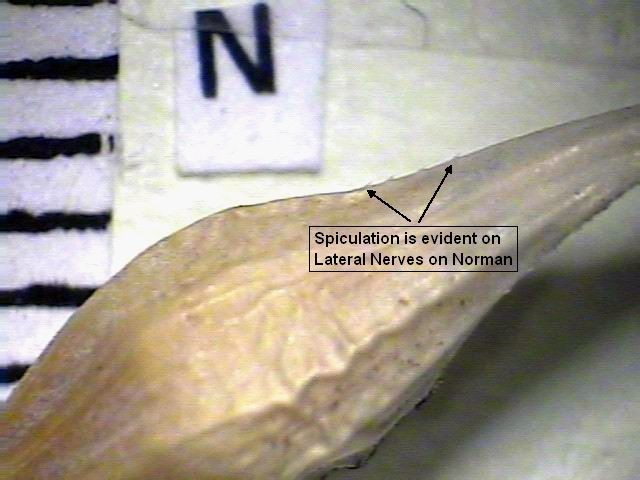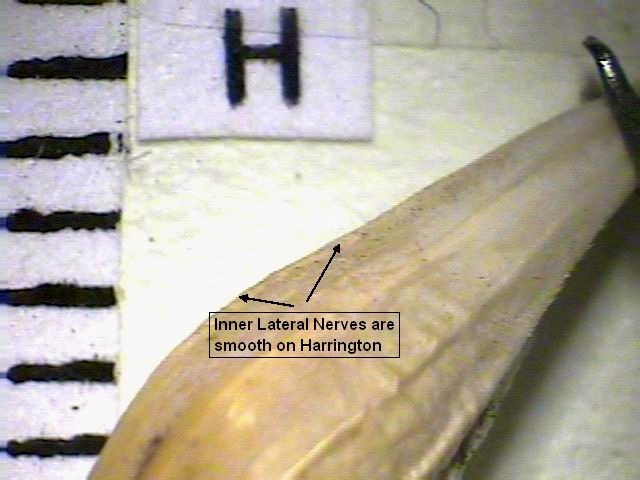Norman
| Denomination: | 'Norman' |
|---|---|
| Previously Proposed Denomination: | 'TR05915' |
| Botanical Name: | Hordeum vulgare |
| Applicant/Holder: |
Agriculture & Agri-Food Canada, Brandon Brandon Research Centre, 18th St. & Grand Valley R P.O. Box 1000A, R.R. #3 Brandon, Manitoba R7A 5Y3 Canada |
| Breeder: |
Bill Legge, Agriculture & Agri-Food Canada, Brandon, Manitoba |
| Agent in Canada: |
Agriculture & Agri-Food Canada Office of Intellectual Property and Commercialization 107 Science Place Saskatoon, Saskatchewan S7N 0X2 Canada Tel: (306) 203-1383 |
| Application Date: | 2008-05-13 |
| Application Number: | 08-6334 |
| Grant of Rights Date: | 2010-11-25 |
| Certificate Number: | 3971 |
| Date rights surrendered: | 2013-11-06 |
Variety Description
Varieties used for comparison: 'CDC Kendall', 'AC Metcalfe' and 'Harrington'
Summary: 'Norman' has a low to medium frequency of plants with recurved flag leaves while it is medium to high for 'CDC Kendall' and absent to very low for 'AC Metcalfe' and 'Harrington'. The intensity of anthocyanin colouration of the auricles of the flag leaves of 'Norman' is medium to strong while it is very weak to weak for 'AC Metcalfe'. 'Norman' has sparse pubescence on the auricles of the flag leaves while it is absent to very sparse for 'AC Metcalfe' and 'Harrington'. The lemma awns at anthesis of 'Norman' have medium to strong intensity of anthocyanin colouration while it is very weak in 'AC Metcalfe'. 'Norman' has a longer spike than 'AC Metcalfe'. The length of the first segment of the rachis of 'Norman' is shorter than in 'CDC Kendall' and 'Harrington'. 'Norman' has a weak curvature of the first segment of the rachis while it is medium to strong curvature in 'CDC Kendall'. The spiculation of inner lateral nerves of the dorsal side of the lemma of the kernel in 'Norman' is weak to medium while it is absent to very weak in 'Harrington'. 'Norman' mainly has horseshoe shaped basal markings on the kernel while it is mainly incomplete horseshoe shaped markings in 'CDC Kendall'. 'Norman' has fair to good resistance to lodging while it is poor to fair in 'Harrington'.
Description:
PLANT: spring type, 2-row, malting barley, erect to semi-erect growth habit at the 5-9 tiller stage, absent to very sparse pubescence on the lower leaf sheaths at the 5-9 tiller stage, low to medium frequency of plants with recurved flag leaves, mid season spike emergence
FLAG LEAF: medium to strong intensity of anthocyanin colouration of the auricles, weak pubescence along the margins of the auricles, medium to strong glaucosity of the sheath, absent to very weak pubescence on the sheath, weak pubescence on the blade
SPIKE: medium to strong glaucosity at the end of anthesis, semi-erect to horizontal attitude at the end of anthesis, closed cup collar with V shape, parallel shape, medium density, absent or very weak anthocyanin colouration of the nerves of the lemma of the kernel at the soft dough stage, weak curvature of first segment of rachis, divergent sterile spikelet attitude, longer glume and its awn relative to grain of median spikelet
LEMMA AWNS: medium to strong intensity of anthocyanin colouration of the tips at the beginning of anthesis, longer when compared to spike, rough spiculation along margin
KERNEL: whitish aleurone layer, long rachilla hair, husk present, weak to medium spiculation of inner lateral nerves of dorsal side of lemma, no hairiness of ventral furrow, clasping disposition of lodicules, horseshoe shaped basal markings
AGRONOMICS: fair to good resistance to lodging, good to very good malting quality
DISEASE RESISTANCE: very susceptible to True Loose Smut (Ustilago nuda); susceptible to Spot Blotch (Cochliobolus sativus), Septoria Speckled Leaf Blotch (Septoria passerinii), Scald (Rhynchosporium secalis), Stem Rust (Puccinia graminis), Covered Smut (Ustilago hordei), False Loose Smut and Black Semi-Loose Smut (Ustilago nigra) and Barley Yellow Dwarf virus; moderately susceptible to Common Root Rot (Cochliobolus sativus, Fusarium spp.) and Net Blotch net-form (Pyrenophora teres); moderately resistant to Fusarium Head Blight (Fusarium graminearum, perfect state Gibberella zeae) and resistant to Net Blotch spot form (Pyrenophora teres)
Origin & Breeding History: 'Norman' (experimental designation TR05915, CDC KendallDT002-4) is a doubled haploid line selected from 'CDC Kendall' using in vitro selection with deoxynivalenol (DON) during the anther culture step at Agriculture & Agri-Food Canada's Brandon Research Centre, Brandon, Manitoba in 2000. 5 doubled haploid plants were produced, one of which became 'CDC KendallDT002-4'. They were grown in a greenhouse and were individually harvested in October 2000. In 2001, 'CDC KendallDT002-4' was planted in an FHB nursery in Brandon, Manitoba and was evaluated visually on a 0-5 scale for FHB reaction, row harvested by hand, threshed and cleaned. A 1 gram ground sub-sample was sent to ECORC-AAFC, Ottawa for DON analysis. 'CDC KendallDT002-4' had lower DON concentration than 'CDC Kendall' and was advanced to preliminary yield tests at Brandon, Manitoba in 2002-2003. In 2003, it was evaluated in a FHB nursery in Charlottelown, PEI. It was evaluated in an advanced yield test in 2004 and was entered in the 2005-2006 Western Cooperative Two Row barley registration test. It was then evaluated in the 2006-2007 Collaborative Malting Barley Trials. DON analysis were conducted on the cooperative and variety trials and showed that 'Norman' continued to have considerably lower DON content than 'CDC Kendall'. It continued to be evaluated in 5 FHB nurseries from 2005-2007 and was evaluated in the 2006 North American Barley Scab Evaluation Nursery grown in Brandon and 4 locations in the USA.
Tests & Trials: Tests and trials were conducted during the summers of 2008 and 2009 in Brandon, Manitoba. Plots consisted of 6 rows with a row length of 4 meters and a row spacing of 0.18 meters. Plots were spaced 0.46 meters apart. There were 4 replicates arranged in a RCB design.
Comparison tables for 'Norman' with reference varieties 'CDC Kendall', 'AC Metcalfe' and 'Harrington'
Spike length (excluding awns)(cm)
| 'Norman' | 'CDC Kendall' | 'AC Metcalfe' | 'Harrington' | |
|---|---|---|---|---|
| mean 2008 | 9.5 | 9.2 | 8.5 | 9.5 |
| std. deviation | 1.7 | 1.5 | 1.3 | 1.4 |
| mean 2009 | 9.6 | 9.1 | 8.5 | 9.7 |
| std. deviation | 1.1 | 1.1 | 0.9 | 0.9 |
Deoxynivalenol (DON) levels (parts per million) from 2001 to 2007 at the Brandon FHB Nursery
| 'Norman' | 'CDC Kendall' | 'AC Metcalfe' | 'Harrington' | |
|---|---|---|---|---|
| mean (LSD=3.4) | 10.4 | 15.0 | 15.2 | N/A |
Click on image for larger view

Barley: 'Norman' (top) with reference variety 'CDC Kendall' (bottom)
Click on image for larger view

Barley: 'Norman'
Click on image for larger view

Barley: Reference variety 'Harrington'
- Date modified: